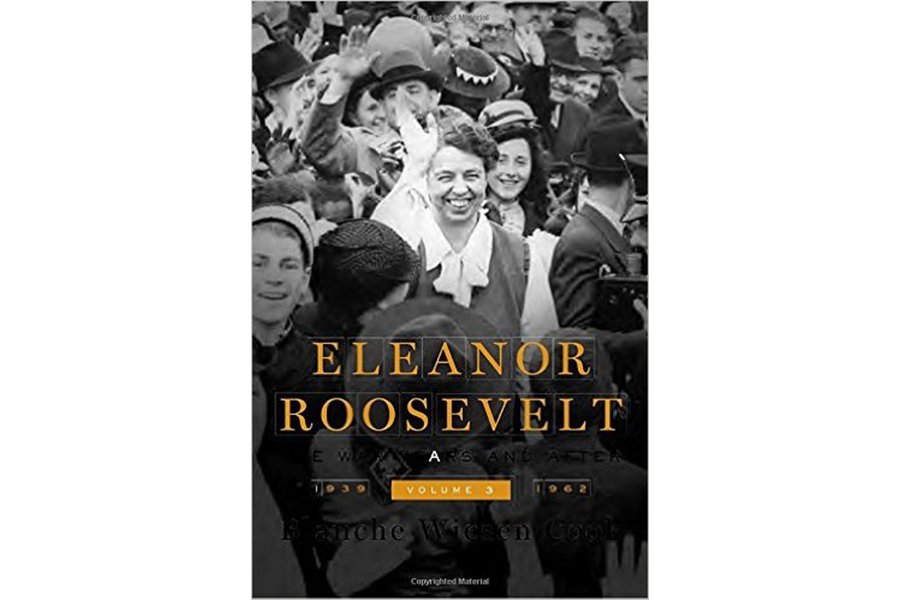'Eleanor Roosevelt: The War Years and Beyond' is a touchingly human portrait
Loading...
Blanche Weisen Cook concludes her magisterial three-volume biography of the woman Harry Truman called "First Lady of the World" with Eleanor Roosevelt: The War Years and Beyond, 1939 - 1963, a thoroughly researched and immensely readable account of her subject's rapid evolution from one of the country's most remarkable First Ladies (and its longest-serving, through all three of her husband's terms in office and the portion of his fourth he managed to serve before his death in April of 1945) to an even more remarkable citizen of the world in her own right.
The seeds of such a transformation had always been present in the young woman who was born into the upper echelon of Gilded Age New York society but chafed against its narrow limitations almost from her earliest years (years related with Edith Whartonesque storytelling gravitas in Cook's first volume). Eleanor married her cousin Franklin Roosevelt in 1905 in a ceremony witnessed by her uncle, President Theodore Roosevelt (he joked that it was nice to keep the name in the family). And in 1918, she made the kind of discovery that can either be the making or unmaking of even the strongest person: Her husband was conducting a protracted love affair with another woman.
As those Edith Wharton readers will expect, a deal was struck. The marriage continued as a public and economic union, but Eleanor, having lost the trust that wives expect to feel for their husbands, freed herself also from the quiet subservience most society wives at the time were forced to endure. Thanks to a revelation she herself would very much like to have avoided, Eleanor Roosevelt, in other words, was free to become her own person. Scarcely has public servant in American history put such freedom to better use.
During the war years when her husband was leading the fight against the Axis powers – the main subject of this volume – she tirelessly supported his efforts (variations of “tireless” crop up throughout Cook's book, echoing the sentiment of one of the First Lady's old friends: “Eleanor keeps at the work until it's done”). Cook does a stirringly sensitive job describing the core beliefs that gave “ER” strength even in the war's darkest days. “She imagined a world without war and understood that peace would remain a chimera so long as entire nations and subject peoples were denied access to economic security: food, clothing, education, work, health, and comfort,” Cook writes. “She understood power, sought power, and influenced policy from positions of power.” She was, in Cook's particularly apt phrase, “a practical idealist.”
It was an uneasy domestic alliance, sharing that power with a husband who could vary in a single afternoon from prickly and remote to warmly supportive. Cook portrays an Eleanor who tries to advocate her own agenda – championing youth groups and trying to alleviate the plight of refugees fleeing from the violence of the war – while also acting as one of FDR's most visible and most beloved surrogates, both on Capitol Hill and before the nation. The First Lady more often encountered resistance from her own “side”; FDR could be witheringly disdainful of the very causes Eleanor championed. Cook tells in cringe-inducing detail one such incident, for instance, when FDR was dismissive of the American Youth Congress in 1940, addressing them from the balcony of the White House with Eleanor at his side but departing from his prepared remarks to scold their views as “twaddle” while his wife looked on stoically. There were many such instances in the years that fill the bulk of Cook's book.
It's always been nearly impossible to avoid the suspicion that Eleanor was relieved when FDR died; it's likewise easy to suspect that Cook is just a bit pleased to see the last of a man who was inspired as a national leader but a wretched, desperate, faithless coward as a husband. In these latter years, Eleanor was free to pursue her own agenda in dozens of ways; she urged the participation of the United States in the newly-created United Nations and was the country's first delegate there. She wrote and spoke endlessly in venues large and small, urging her listeners to imagine a better, fairer world – and then to go out and work to bring it about. She believed, as Cook writes, that “fulfilling the promise of America's democracy required enlarging it so that it embraced everyone,” and in the final two decades of her life, she worked constantly to “save and expand the New Deal, to end racial violence, bigotry, and discrimination, and to support youth and youth movement.”
Cook captures the headlong energy of those years perfectly, and she blends the international with the personal easily and comfortably, grounding her portrait in the troves of letters and diaries Eleanor and her friends and relatives kept over many decades. Readers will encounter in these pages an intimate, touchingly human Eleanor Roosevelt – an icon they can both admire and genuinely like.








